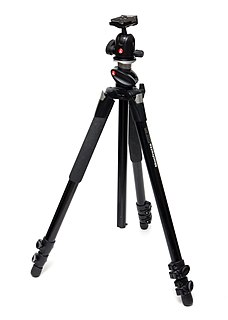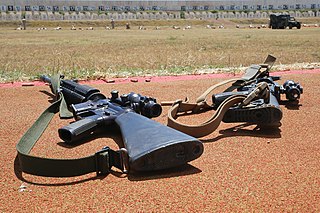
In firearms, rifling is the helical groovings that are machined into the internal (bore) surface of a gun's barrel, for the purpose of exerting torque and thus imparting a spin to a projectile around its longitudinal axis during shooting. This spin serves to gyroscopically stabilize the projectile by conservation of angular momentum, improving its aerodynamic stability and accuracy over smoothbore designs.

A caster is an undriven, single, double, or compound wheel that is designed to be attached to the bottom of a larger object to enable that object to be moved. They are available in various sizes, and are commonly made of rubber, plastic, nylon, aluminum, or stainless steel.
The M40 rifle is a bolt-action sniper rifle used by the United States Marine Corps. It has had four variants: the M40, M40A1, M40A3, and M40A5. The M40 was introduced in 1966. The changeover to the A1 model was completed in the 1970s, the A3 in the 2000s, and the A5 in 2009.
The Franchi SPAS-12 is a combat shotgun manufactured by Italian firearms company Franchi from 1979 to 2000. The SPAS-12 is a dual-mode shotgun, adjustable for semi-automatic or pump-action operation. The SPAS-12 was sold to military and police users worldwide, as well as on the civilian market, and has been featured in many films, TV shows, and video games.

The Stoner 63 is a 5.56×45mm NATO modular weapon system. Using a variety of modular components, it can be configured as a rifle, a carbine, a top-fed light machine gun, a belt-fed squad automatic weapon, or a vehicle mounted weapon. Also known as the M63, XM22, XM23, XM207 or the Mk 23 Mod 0 machine gun, it was designed by Eugene Stoner in the early 1960s. Cadillac Gage was the primary manufacturer of the Stoner 63 during its history. The Stoner 63 saw very limited combat use by United States forces during the Vietnam War. A few were also sold to law enforcement agencies.

A socket wrench is a type of wrench that inserts into a socket to turn a fastener, typically in the form of a nut or bolt.

The Gewehr 98 is a German bolt action rifle made by Mauser firing cartridges from a 5-round internal clip-loaded magazine. It was the German service rifle from 1898 to 1935, when it was replaced by the Karabiner 98k, a shorter weapon using the same basic design. The Gewehr 98 action, using a stripper clip loaded with the 7.92×57mm Mauser cartridge, successfully combined and improved several bolt action engineering concepts which were soon adopted by many other countries including the UK, Japan, and the US. The Gewehr 98 replaced the earlier Gewehr 1888 as the main German service rifle. It first saw combat in the Spanish-American war, the Chinese Boxer Rebellion and was the main German infantry service rifle of World War I. The Gewehr 98 saw further military use by the Ottoman Empire and Nationalist Spain.

In photography, a tripod is used to stabilize and elevate a camera, a flash unit, or other photographic equipment. All photographic tripods have three legs and a mounting head to couple with a camera. The mounting head usually includes a thumbscrew that mates to a female threaded receptacle on the camera, as well as a mechanism to be able to rotate and tilt the camera when it is mounted on the tripod. Tripod legs are usually made to telescope, in order to save space when not in use. Tripods are usually made from aluminum, carbon fiber, steel, wood or plastic.

A tow hitch is a device attached to the chassis of a vehicle for towing, or a towbar to an aircraft nose gear. It can take the form of a tow ball to allow swiveling and articulation of a trailer, or a tow pin, or a tow hook with a trailer loop, often used for large or agricultural vehicles where slack in the pivot pin allows similar movements. Another category is the towing pintle used on military vehicles worldwide.
A torque limiter is an automatic device that protects mechanical equipment, or its work, from damage by mechanical overload. A torque limiter may limit the torque by slipping, or uncouple the load entirely. The action of a torque limiter is especially useful to limit any damage due to crash stops and jams.

Rail interface system or rail integration system is a generic term for a standardized rail system for attaching accessories to small firearms such as pistols, rifles and light machine guns. Such accessories commonly include tactical lights, laser aiming modules, forward hand grips for improving weapon handling, telescopic sights for long-range targets, and reflex sights/red-dot sights for short/medium-ranged targets, back-up iron sight, bipods/tripods, and bayonets.
A detent is a mechanical or magnetic means to resist or arrest the rotation of a wheel, axle, or spindle. Such a device can be anything ranging from a simple metal pin to a machine. The term is also used for the method involved.
The Sako TRG is a bolt-action sniper rifle line designed and manufactured by the Finnish firearms manufacturer, SAKO of Riihimäki. The TRG-21 and TRG-22 are designed to fire standard .308 Winchester sized cartridges, while the TRG-41 and TRG-42 are designed to fire more powerful and dimensionally larger .300 Winchester Magnum (7.62×67mm) and .338 Lapua Magnum (8.6×70mm) cartridges. They are available with olive drab green, desert tan/coyote brown, dark earth or black stocks, and are also available with a folding stock.

A motorcycle trailer is either a trailer used to carry motorcycles or one to be pulled by a motorcycle in order to carry additional gear.

In the context of firearms, a sling is a type of strap or harness designed to allow a shooter to conveniently carry a firearm on their body, and/or to aid in greater hit probability by allowing the firearm to be better braced and stabilized during aiming. Various types of slings offer their own advantages and disadvantages, and can generally be divided into several categories.
The Winchester Model 69 is a bolt-action .22 caliber repeating rifle first produced in 1935 by the Winchester Repeating Arms Company. It was marketed as Winchester's mid-priced bolt-action rimfire sporting rifle, positioned above inexpensive single-shot rifles such as the Model 68 and beneath the prestigious Model 52. An uncommon Model 69 variant, the Model 697, was offered with a telescopic sight and no provisions for iron sights. Production ended in 1963.

A tripod head is the part of a tripod system that attaches the supported device to the tripod legs, and allows the orientation of the device to be manipulated or locked down. Modular or stand-alone tripod heads can be used on a wide range of tripods, allowing the user to choose which type of head best suits their needs. Integrated heads are built directly onto the tripod legs, reducing the cost of the tripod system.

M-LOK, standing for Modular Lock, is a free licensed firearm rail interface system developed and patented by Magpul Industries.

A sling swivel stud, sometimes called an "Uncle Mike type swivel", is a type of mounting point used for attaching slings and bipods to rifles.

A bolt snap is a type of snap hook with a manually operated bolt action slide gate of medium security used to clip a light load to a ring, eye, loop or bight to temporarily secure or suspend an object. They are used for a wide variety of applications including dog leads and for clipping scuba equipment to the diving harness. A similar but more secure device used to attach sails to a stay is known as a piston hank. It differs from a snap shackle in that the load is not carried by the gate. The bolt snap must be actively operated by the user to clip or unclip, and is not easily snagged or unintentionally clipped or unclipped by pressing or bumping against the surroundings. The most common type has a single snap hook at one end and a swivel ring at the other, but double ended bolt snaps and single ended snaps with a swivel shackle are also available. There are a few variations on the style of the hook, gate opening and swivel style. The characteristic element of the bolt snap is the bolt action gate. This is a spring loaded rod which slides longitudinally inside the body of the clip against a compression spring to open the gate of the hook, and returns to rest against the tip of the hook by the action of the spring when released. Bolt snaps are not generally load rated, and are not used to suspend heavy loads. Most applications are in the load range where the user can lift the object to be clipped, or can hold the load manually.














